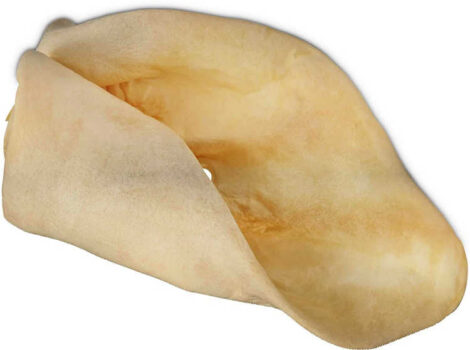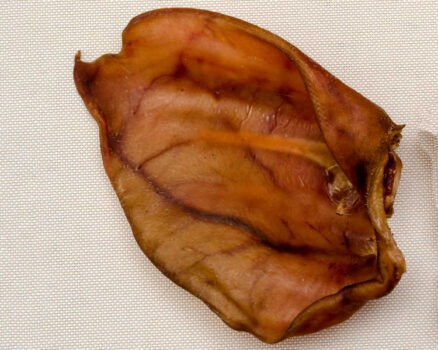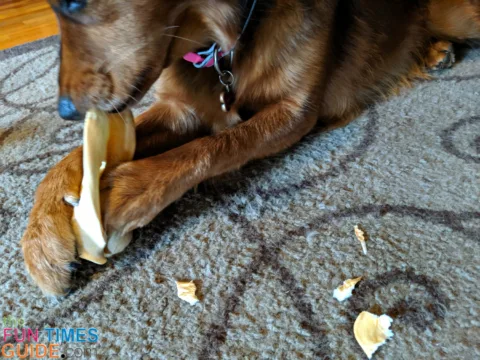This is Post #11 (Cow Ears For Dogs) in a series of articles summarizing the pros & cons of 12 Long-Lasting Dog Chews.
Cow ears are a rare treat for my two dogs!
I may not give them to my dogs very often, but they sure to appreciate it when I do.
Here’s my list of the pros & cons of cow ear chews for dogs. Plus, the difference between cow ears and pig ears as dog chews…
My Experience Giving Dogs Cow Ears To Chew

HOW LONG IT LASTS: Hours
BEST FOR: Light chewers, Small dogs, Senior dogs
TIP: Cow ears get soft as your dog chews on them. Once soft, they’re relatively easy for a dog to tear pieces of it off. While they ultimately digest just fine in a dog’s tummy, I don’t let my dogs swallow any really big pieces.
MY FAVORITE BRAND(S): Pawstruck and Cadet
Cow Ears vs. Pig Ears For Dog Chews

Perhaps the most noticeable difference is in their color:
- Cow ears for dogs are usually an off-white color — because they’ve been disinfected, then baked and dried in an oven.
- Pig ears for dogs are usually a deeper shade of brown — because they’ve been smoked for added flavor.
For the most part, cow ears are the healthier, cleaner, and cheaper option.
Pig ears are:
- Often smoked for added flavor
- Higher in calories, due to the higher fat content in pig ears
- Somewhat smellier than cow ears
- Easily digestible, just like cow ears
- Greasier than cow ears
Pros & Cons: What I Like Best (And Least) About Cow Ears For Dogs
Because cow ears dog chews look so much like rawhide, at first I thought they were considered rawhide chews. But they’re not rawhide at all!
Rawhide is the inner layer of a cow’s hide or a horse’s hide — it does not dissolve in a dog’s stomach. Instead, it swells up in your dog’s belly — forcing your dog to pass any rawhide pieces that they’ve swallowed. (This can lead to throat blockage or bowel blockage.)
Cow ears are actually cartilage wrapped in a thin skin — there’s no splintering at all.
They’re 100% digestible.
Cow ears are high in protein and low in fat — which makes a great low-calorie dog treat.
They provide somewhat of a challenge for your dog to gnaw on and chew into pieces. (My dogs can demolish these in less than an hour sometimes though.)
NOTE: Even though they are easily digestible (and yes, my dogs have swallowed the larger pieces on several occasions), I generally don’t let my dogs eat any really large pieces that they have chewed off of cow ears.
Where To Find Cow Ears For Dogs
Cow ears are readily available in grocery stores, department stores, pet stores, and online.
If I’m out and about and near a Petco, then I will usually grab one for each of my dogs there. (They sell the Good Lovin’ brand.)
However, most of the time I buy them from Pawstruck. They get much cheaper the more you buy — Pawstruck sells them in packages of 10, 25, 50, 100, and 250.
My second favorite brand for cow ear chews is Cadet. They sell high-quality cow ears in a package of 12.

Want to try the cow ears that my dogs like best?
Like this post? Save it to read again later… or share with others on Pinterest!






